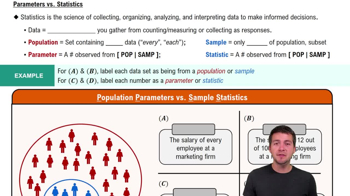Here are the essential concepts you must grasp in order to answer the question correctly.
Population Parameter
A population parameter is a numerical value that summarizes a characteristic of an entire population. It is a fixed value that is often unknown and can only be estimated through sampling. In the context of the question, if the percentage of 24.7% were derived from the entire population of household food purchasers, it would be considered a population parameter.
Recommended video:
Parameters vs. Statistics
Sample Statistic
A sample statistic is a numerical value that summarizes a characteristic of a sample drawn from a population. It is used to estimate the corresponding population parameter. In this case, the 24.7% figure comes from a survey of 1000 households, making it a sample statistic that reflects the behavior of a subset of the larger population of all household food purchasers.
Recommended video:
Sampling Distribution of Sample Proportion
Sampling Methodology
Sampling methodology refers to the techniques used to select individuals from a population to participate in a study. The validity of a sample statistic depends on how representative the sample is of the population. Understanding the sampling method used in the survey is crucial for assessing the reliability of the 24.7% statistic and determining whether it can be generalized to the entire population.
Recommended video:
Sampling Distribution of Sample Proportion
 Verified step by step guidance
Verified step by step guidance Verified video answer for a similar problem:
Verified video answer for a similar problem:



 2:13m
2:13m